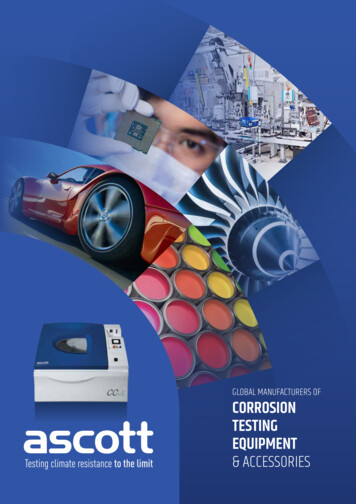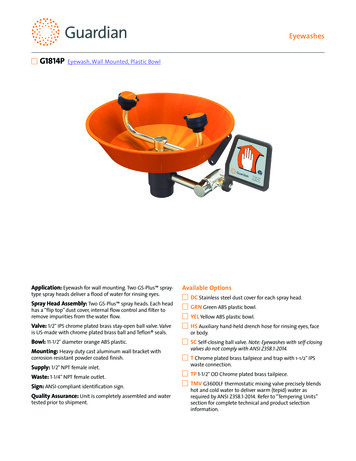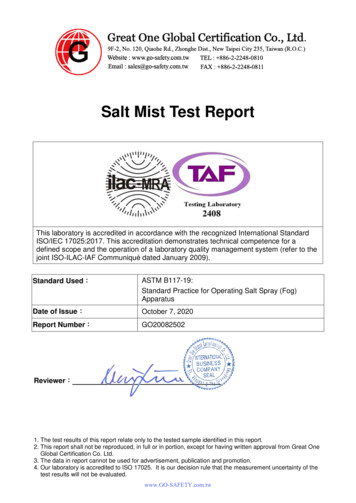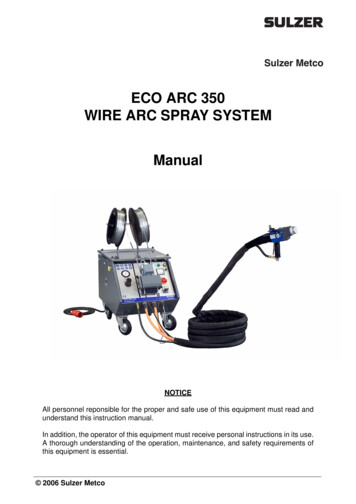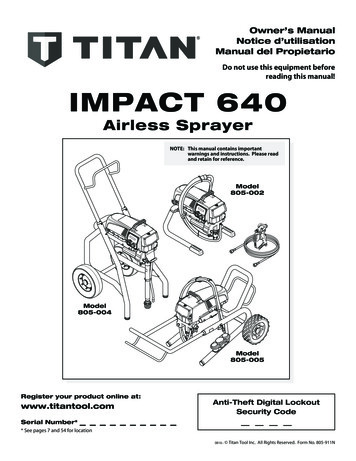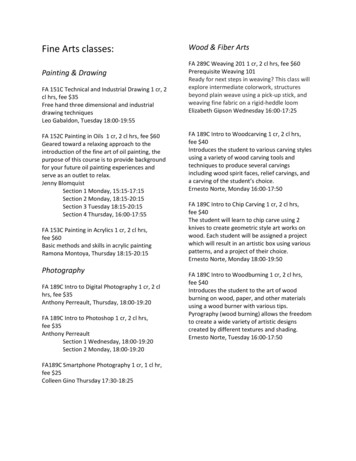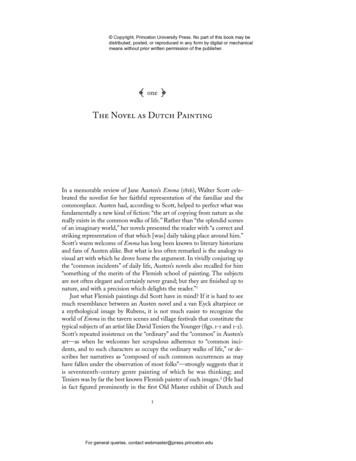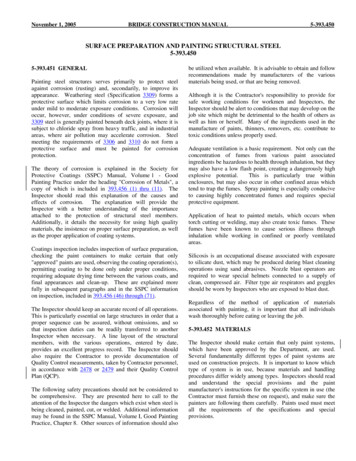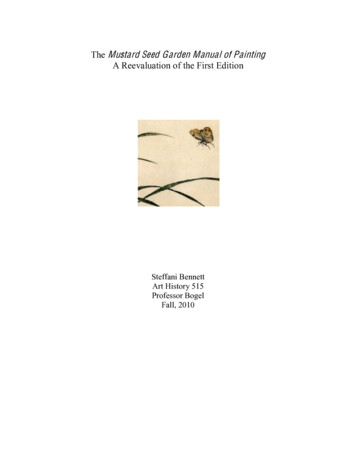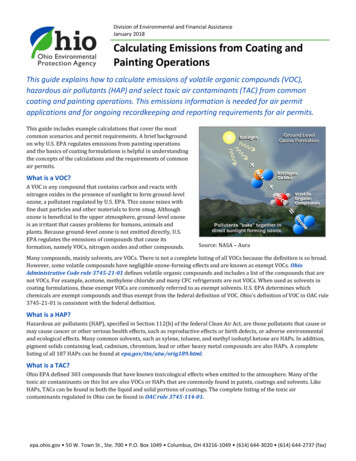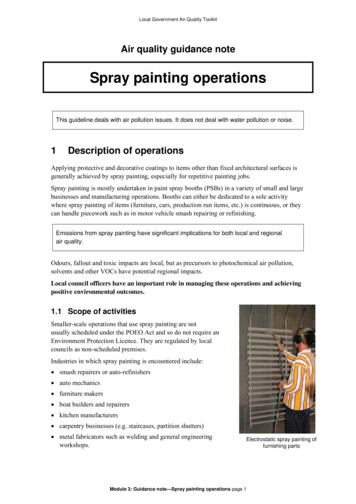
Transcription
Local Government Air Quality ToolkitAir quality guidance noteSpray painting operationsThis guideline deals with air pollution issues. It does not deal with water pollution or noise.1Description of operationsApplying protective and decorative coatings to items other than fixed architectural surfaces isgenerally achieved by spray painting, especially for repetitive painting jobs.Spray painting is mostly undertaken in paint spray booths (PSBs) in a variety of small and largebusinesses and manufacturing operations. Booths can either be dedicated to a sole activitywhere spray painting of items (furniture, cars, production run items, etc.) is continuous, or theycan handle piecework such as in motor vehicle smash repairing or refinishing.Emissions from spray painting have significant implications for both local and regionalair quality.Odours, fallout and toxic impacts are local, but as precursors to photochemical air pollution,solvents and other VOCs have potential regional impacts.Local council officers have an important role in managing these operations and achievingpositive environmental outcomes.1.1 Scope of activitiesSmaller-scale operations that use spray painting are notusually scheduled under the POEO Act and so do not require anEnvironment Protection Licence. They are regulated by localcouncils as non-scheduled premises.Industries in which spray painting is encountered include: smash repairers or auto-refinishers auto mechanics furniture makers boat builders and repairers kitchen manufacturers carpentry businesses (e.g. staircases, partition shutters) metal fabricators such as welding and general engineeringworkshops.Electrostatic spray painting offurnishing partsModule 3: Guidance note—Spray painting operations page 1
Local Government Air Quality Toolkit1.2 Surface coating systemsConventional surface coatings or paints applied in spraypainting are usually a mixture of: resins or polymers which ‘cure’ or ‘harden’ to produce adurable coating on the application surface coloured pigments and fillers, and solvents or water acting as carriers for the resins thatevaporate during application and drying.Coatings are:– solvent-based or– water-borne.Solvent-based coatingstend to predominate innon-production lineoperations, such assmash repairers.Solvent-based coatings were the first to be developed and aregenerally the preferred type for smash repairs.Water-borne coatings also contain small amounts of solvents.Water-borne coatings are used by vehicle manufacturers forundercoats and primers, but are mostly unsuitable for refinishingbecause of relatively long drying times. Top coats or finish coatshave tended to be solvent-based for automobile coatings.Categories of solventbased coatings are:changingsolventcontent– lacquers– enamels– urethanesSolvent-based coatingsSolvent-based coatings can be further categorised into the orderin which they were developed or ‘evolved’ in the industry as lacquers enamels, and urethanes (two-pack systems).The quality and durability of the final finish, from lacquersthrough enamels to urethanes, depends to an increasing degreeon cross-linking and polymerisation of the resins afterapplication. The amount of solvent in the formulation tends todecrease as the polymerisation increases.From an air-quality perspective (i.e. in relation to VOC emissions)the more recently developed urethanes are the most preferable,but they can pose an occupational problem for applicatorsbecause they contain isocyanates, to which asthma sufferers areparticularly sensitive.Module 3: Guidance note—Spray painting operations page 2
Local Government Air Quality ToolkitSmash repairers or auto-refinishersSmash repair or auto-refinishing operations involve: vehicle preparation vehicle priming top coat application, and equipment clean-up.Blending repair coatings to match the surrounding vehicle finish calls for the application ofsuccessively thinner coats and more solvents.Smash repairers commonly have to use paint systems which are different from those usedby vehicle manufacturers.The systems used by smash repairers typically have more solvent emissions.Vehicle manufacturers apply coatings using production line machinery in an enclosed process.Here the metallic vehicle bodies or body parts can be baked whole in an oven to cure thecoating. These systems also collect and control VOC emissions from the baking ovens.Smash repairers cannot use heat curing to the same extent or at the same temperature asmanufacturers, because of the jobbing-style of their operations and the need to work on vehiclesalready fitted with internal trim. The coatings, formulations and techniques used in themanufacturers’ production lines, including some water-based formulations, are thereforegenerally not suitable for repairs and refinishing.1.3 Operation of spray paintingSpray painting refers to the process of atomising a paint-solvent mix—forming a mist of fineliquid aerosol paint droplets 10–50 μm (micrometres) in diameter—in a ‘gun’ under pressure,and applying the aerosol spray onto the object or surface to be painted.The sprayed surfaces are then allowed to ‘tack off’ when the volatile solvents evaporate leavinga uniform coating.A dry-off period follows, giving the coating time to harden or cure.Most paint solvents and thinners are flammable, many are odorous and some are potentiallytoxic. The application of sprayed paint must be conducted in a situation where the air pollutantsemitted are controlled for both operators and neighbours. This is accomplished with spraybooths and extraction ventilation and dispersion systems, considered further below.The dominant method of spray application has been a compressed air gun (40–70 psi) witheither gravity, suction or pressure feeding of the paint-solvent mix. More recently, high-volumelow-pressure (HVLP) suction-feed guns have been developed using lower pressure (5–10 psi).HVLP application reduces ‘bounce back’ from the work piece, and overspray is also reduced.Electrostatic spray systems also offer a higher efficiency of application.Module 3: Guidance note—Spray painting operations page 3
Local Government Air Quality Toolkit2Potential emissions to airThe potential emissions to atmosphere from spray painting operations are: evaporated solvents (as VOCs) from drying of coating formulations, thinners and cleaners odours, caused by odorous solvents and VOCs toxic compounds, to the extent that solvents, thinners and cleaners are toxic coating overspray or ‘carryover’, and sanding and blasting dust arising from surface preparation in some activities, such assmash repairing or timber painting.Evaporated solvents, odours and dust are the most common problems encountered at localgovernment level in dealing with small to medium-scale spray painting activities.2.1 Local impactsEfficient capture in a spray booth at the point of evaporation does not in itself preventemission of solvents, odours and toxic compounds.Overspray and sanding dust can cause local soiling and fallout problems. Most paintoverspray will dry in the air during transport from the emission point to the ‘target’ so ‘wet’paint fallout is rarely a problem. Fallout problems are usually recognised due to a complaint.Many solvents and thinners are odorous. Some solvents and thinners are also toxic. Onceevaporated, solvents will be emitted from the spray painting establishment unless they arecontained in a capture or ventilation system and either removed from the air stream ordestroyed. Capture alone does not eliminate the emissions.Local impacts from small to medium-sized establishments are typically ameliorated bydispersion of solvent emissions to acceptable levels in the environment. Alternatively, coatingformulations can sometimes be changed to reduce solvent emissions or substitute less odorousor toxic solvents.Module 3: Guidance note—Spray painting operations page 4
Local Government Air Quality Toolkit2.2 Regional impactsSolvents evaporated in spray painting are precursors tophotochemical air pollution (‘smog’). In the presenceof strong sunlight they react with nitrogen oxides in theatmosphere to form ozone and other undesirablephotochemical air pollutants.This is a regional impact. The time taken for thesolvents emitted from spray painting to reactphotochemically is typically from three to four hours.(See diagram above.) By that time the air parcelcontaining the emissions will have moved to anotherlocality in the air basin. (Refer to Module 1 of thisToolkit.)While not a dominant component, it is significant giventhe broad Government approach that each emissionsource should bear a proportionate responsibility forcontrol of total emissions.End-of-pipe controls, such as carbon adsorbers andthermal oxidisers, are not generally cost effective forsmall establishments such as smash repairers. They are,however, feasible in larger manufacturingestablishments.In California, where smog and toxics control has had avery high priority, the allowable solvent content insurface coating formulations used by spray painters hasbeen progressively reduced by legislative pressure overthe past 30 years. The development of lower-VOCemission formulations in this jurisdiction has resultedin spin off benefits for other places, such as Australia,where solvent content is not (yet) legislated for airquality.Emission4-hour airtrajectorySmog impactEach year over 4,000 tonnesof VOCs are discharged to the airfrom smash repairers in Sydney.These contribute about 3% tooverall VOC smog precursors.Californian air quality regulatorshave forced major developmentsin low-VOC emissionformulations for spray painting.Some of these formulations areavailable in Australia.In general, local council officers will not be in a position to require significant reductions inVOC emissions from spray painting. But they should be aware that, in situations where localcircumstances require such a reduction, as distinct from dispersion, there are wider regionalbenefits in addition to local air quality.Module 3: Guidance note—Spray painting operations page 5
Local Government Air Quality Toolkit3SolutionsThere are essentially two practical solutions to localair pollution problems from small to medium-scalespray painting operations: filtration or scrubbing to remove particles anddroplets of resin, and dispersion of evaporated solvents to controlodours and exposure to toxic materials.Both techniques assume that capturing andcontaining emissions at source in the spray paintingestablishment is efficient and effective. In otherwords, work should be done in properly designedand well-maintained spray booths to the maximumextent possible.Dispersion can reduce odour impactsfrom spray paintingA few other measures are important in mitigatingimpacts: good housekeeping efficient application of coatings in the sprayingoperation proper disposal of solvents and thinners.These can result in small but significant reductionsof emissions, especially of solvents and thinners.In some situations a change to a new coating or paintformulation might remove particularly odorous ortoxic materials from the emissions and contribute tothe solution of a local problem.A properly designed and well-maintainedspray booth ensures efficient capture ofspray painting emissionsLow emission and zero emission paints are available and, though expensive and sometimesresulting in a ‘lower quality’ (less glossy) finish, they may appeal to customers who want anenvironmentally friendly paint.For larger installations and production line coating applications, air pollution control equipmentto reduce emissions may be warranted, such as carbon adsorbers or thermal or catalyticoxidisers. (See Module 3 Part 1, ‘Air pollution control techniques’.)3.1 Identifying specific problemsBefore going on site for an inspection or assessment the following should be checked:– the consent conditions for the premises or the activity, and– any previous reports on file including diagrams, photographs, maps, etc.Module 3: Guidance note—Spray painting operations page 6
Local Government Air Quality ToolkitCommon sources of emissionsEmissions to air occur from the following points: the booth exhaust vent or stack, where the aerosols not caught by the filter and the solventvapour are released to atmosphere the dry-off area, either as fugitive or captured emissions the exhaust vent of any baking oven where residual solvent vapours are released the paint preparation and spray gun cleaning areas, where paint and cleaning solvent vapoursare released, and the surface preparation area, if it is not enclosed and hooded to capture dust (e.g. fromsanding and sand blasting).General guidance for an investigation into complaints of odour and fallout are outlined inModule 3 Part 2, ‘Practical regulation of air pollution sources’.A ‘sniff survey’ around the installation will often reveal a problem. Observations should bemade both upwind and downwind and the wind strength and direction noted. However, if it iswarm and sunny or windy when the ‘sniff survey’ is done, odours which would be detectable inrelatively still, cooler conditions may not be detected. Several surveys are desirable. Refer to themeteorology information in Module 1 section 2 for a description of the best meteorologicalconditions for a survey, e.g. when dispersion is poor.Identifying specific sources of emissionsAn inspection of a spray painting operation shouldcover all phases of the process. (See also the attachedchecklists). Make sure that an inspection covers thefollowing aspects of the operation:Mix preparation Where is the paint-solvent mix prepared? Preparation is often carried out in a separatepaint-mixing room to protect workplace healthstandards, but this will not reduce solventemissions unless the exhaust gas is treated.Separate paint-mixing rooms with proper exhaustsystems can improve dispersion.All phases of a spray paintingoperation should be inspected Mixing should not be carried out in workshopdoorways where immediate neighbours can beexposed to solvent evaporation. Is solvent evaporation occurring in ventilatedbooths? Check solvent evaporation from sprayapplication and drying off.Where are sprayed items dried off? If not, then fugitive solvent emissions will be at alower vertical height than the stack and thereforedispersion will be less effective.Module 3: Guidance note—Spray painting operations page 7
Local Government Air Quality ToolkitSanding and surface preparation Is this carried out in booths with filtered or scrubbedexhausts?Clean-up of spray guns and equipment Is this done in a controlled space?Extraction booth filter and ducting Is the extraction system designed and operatedaccording to Australian Standard AS 4114.1 and4114.2? Is the filter cleaned or replaced regularly? Are there any gaps around the filter medium? Do the doors close tightly during operation?Doors securely closedduring operation? Is there adequate draft through any openings in thebooth, e.g. 0.5 m/s minimum across any open face? Is the booth a down flow or cross flow arrangement?(See diagrams at right.) Is the booth under negative pressure? Is there a pressure gauge? Is the pressure drop across the booth and filtergreater than 60 Pa (0.25 inches water gauge)? If pressure drop becomes too high, flow through thebooth is reduced and fugitive emissions increase,causing possible odour complaints.Down flow spray boothSpray gun types Are the spray guns: standard pressure HVLP or electrostatic?More efficient paint application (i.e. using HVLP orelectrostatic guns) reduces the amount of solventevaporation.Cross flow spray boothBooth manometer, useful for detectingblocked filters or poor ventilation flows.Module 3: Guidance note—Spray painting operations page 8
Local Government Air Quality ToolkitWaste disposal Are spent solvents disposed of by licensed wastecontractors? Are spent solvents held in closed systems for disposaland not exposed for evaporation?Discharge stacks Discharge stacks should be designed according toAustralian Standard AS 4114.1 and 4114.2, with astack height at least 3 m above the highest point of theroof line. The design discharge velocity should be between12 and 15 m/s. Stacks should have a vertical discharge not impededby an old-style rain protector.Stacks should be high enough so that dispersion is notimpeded by downwash from buildings or by other tallobjects such as trees acting as wind barriers (seeModule 1 section 2 and Module 3 Part 1,‘Air pollutioncontrol techniques’ section 3).Carefully designed equipmentfor clean-up and disposal of thinnersand cleaning solvents can reducesolvent emissions3.2 Industry good practiceIn addition to generating air emissions, spray paintingoperations also work with a high risk of creating otherenvironmental problems, such as water contamination,incorrect waste handling and treatment or threats to healthand safety in the workplace. Work practices whichaddress these issues often also constitute good practice forair pollution control. Good housekeeping and orderly,well-documented operations contribute to minimisingemissions to air (e.g. due to fewer spills or accidents).The hazard, safety and occupational health issuesassociated with spray painting are considerable. Manymaterials handled are not only toxic (e.g. solvents,isocyanates) but also flammable. WorkCover NSWadministers the relevant occupational health and safetylegislation for spray painting. The WorkCover NSWHealth and Safety Guide, Spray Painting, Guide 2001should be consulted for industry requirements and goodpractice (available at www.workcover.nsw.gov.au). Itcovers many aspects including ventilation requirements,storage of dangerous and flammable materials and storageand handling of the many materials involved.Dispersion impeded by treesDispersion impeded by adjacentbuildingsModule 3: Guidance note—Spray painting operations page 9
Local Government Air Quality ToolkitCompliance with occupational health and safety requirements can also improveenvironmental performance, but is no guarantee that environmental requirementswill be met.Good practice tipsThe following list of good practice tips for spray painting operations has been developed byMarrickville Council and DECC.Solvent and paint handlingThe solvents emitted from spray painting are VOCs and contribute to photochemical smog, sousing more efficient spray guns to minimise paint and solvent emissions is worthwhile. As somesolvents are also toxic minimising their emissions is worthwhile from this perspective too. Don’t place solvents in garbage bins. Solvents should be recycled or collected by a licensed contractor. Spray guns should be cleaned in gun wash bays or using purpose-designed equipment. Airless or HVLP spray guns are the preferred type of gun. Spray paint should be directed towards exhaust systems. Solvent containers should be sealed when not in use. Don’t spray paint outside booths. Mix paint in a ventilated room. Solvent recovery units should be in well ventilated areas with adequate exhaust to ensuredispersion. If possible switch to less toxic materials.If switching formulations to avoid toxic materials is not feasible, dispersion is the main optionfor toxic emissions. Consult the DEC publication Approved methods for the modelling andassessment of air pollutants in NSW (2005) to make sure dispersion (stack height or separationdistance) is adequate.Filters, scrubbers and adsorbersMake sure the following requirements are complied with: equipment always maintained in good working condition routine maintenance program in place filter medium fully covering the support frame spare filters kept on site booths not operated when filters, scrubbers or adsorbers are not in place if scrubbers are installed, there is a routine clean out of accumulated solids and scrubbingliquor is disposed of in an approved manner if adsorbers are installed for odour control (as a last resort), the adsorbent is replaced when‘breakthrough’ occurs.Module 3: Guidance note—Spray painting operations page 10
Local Government Air Quality ToolkitRemember that scrubbers are not generally effective for removing solvents and odours.Australian StandardsThe relevant Australian Standards for paint spray booths are: AS/NZS 4114.1: 2003 Spray painting booths, designated spray painting areas and paintmixing rooms, Part 1: Design, construction and testing AS/NZS 4114.2:2003 Spray painting booths, designated spray painting areas and paintmixing rooms, Part 2: Installation and maintenance.In general these standards focus on occupational health and safety issues for spray paintingbooths.3.3 Reducing odour impactsWhen an existing spray painting operation presents acontinuing problem (e.g. odours, fallout) and housekeepingand work practices have been brought up to an adequatelevel, further control equipment and process changes shouldbe considered.The two types of equipment to be considered are higherstacks to improve dispersion and control equipment toreduce the rate of emission.Improving dispersionFor spray painting operations, the main option for odourcontrol at the local council level is better dispersion—ifformulation switching is not feasible. Better dispersion isachieved by raising the height of discharge, i.e. installing ahigher stack for the release of air streams containingsolvents and other odours.Options for reducing odourimpact, in priority order are:1 better dispersion—higherstack2 changed paint formulation3 changed procedures4 emission control—adsorbers, thermaloxidisers, catalyticoxidisers.Study by a reputable consultant will often be required,in accordance with DEC publications: Approved Methods for Modelling and Assessment ofAir Pollutants in NSW (2005) and draft policy Assessment and Management of Odoursfrom Stationary Sources in NSW (2001).Such a study will always involve dispersion modelling atthe appropriate level of intensity and will often involvemeasuring the odour concentrations of the emissions.There are a few important aspects for local government toconsider when overseeing these studies, to make sure thebest outcome is achieved:Raising a stack next to a nearbyhigh building can solve an odourproblem without the need for anexpensive dispersion study.Module 3: Guidance note—Spray painting operations page 11
Local Government Air Quality Toolkit Is the consultant competent and experienced in odour assessment and dispersion? Will the surroundings complicate the dispersion modelling? Are high buildings orclumps of high trees in close proximity, or is steeply rising land nearby? These will tend toincrease the uncertainty of modelling predictions. Were the odour strength measurements made under representative operatingconditions? Are these representative conditions likely to vary over time? Changes in paintformulations can make a big difference to the rate of odour emitted as various solvents havewidely differing odour thresholds. Given the high cost of such a measurement and modelling study, would a simple elevationof the stack to well above the height of nearby buildings overcome the problem for thesame expense as the dispersion study? Be aware that predicting the odorous strength of mixtures of odorous compounds is nota reliable science.Installing control equipmentFor most ‘jobbing’-type spray painting operations encountered by local councils,fitting odour control equipment will generally not be feasible.Forget scrubbers—they do not work for odour!Installing equipment to remove solvent from an air stream will generally be a last resort forsmall to medium-sized spray painting operations. The large volumes of air that must beexhausted to ensure adequate health and safety conditions for workers make control equipmentvery expensive and usually well beyond the operator’s financial capability.If there is no other solution than fitting control equipment, then options for consideration are: adsorbers installed after efficient filters thermal oxidisers, or catalytic oxidisers.Refer to Module 3 Part 1, ‘Air pollution control techniques’ for detailed information about theirrequirements.If it proves necessary to install control equipment, the parties involved may take comfort inknowing that controlling VOC emissions will contribute to an improvement in regional airquality.Substituting materialsChanging paint formulations can remove particularly odorous solvents from the operations.But remember, formulations are changing all the time. Vigilance is needed!Changing the paint mix formulation to avoid particularly odorous solvents may be able tosignificantly reduce the odour emission rate while maintaining the quality of finished spraypainting.Module 3: Guidance note—Spray painting operations page 12
Local Government Air Quality ToolkitThis option is best explored by the operator in conjunction with surface coating suppliers.However, to be effective, the changes must be conducted as trials accompanied by reliable andindependent assessment of odour levels in the vicinity.Changing work proceduresA change to procedures can reduce odour impacts in some situations.Operating proceduresAvoiding spray painting operations during late evening or night will help to avoid dispersionconditions in which odour is likely to have greatest impact. However, most smash repairersalready limit their hours of operation from early morning to early evening, often reinforced byconsent conditions.If a problem persists with these limitations already in place, it will not usually be possible tolimit certain types of formulations to times of the day when odour dispersion is likely to bemore effective. The variation in the daytime dispersive capacity of the atmosphere is not usuallysufficient to address odour problems effectively.Operations outside designated hooded areas and booths should be prohibited.Careful handling of solvents, avoiding spills and keeping solvent and paint containers closedwhen not in use are all important measures.Maintenance proceduresIf a business has gone to the expense of installing equipment to overcome environmentalproblems, it pays to spend the little extra required to keep it in good working order and toput in the extra effort of training employees to use it properly.Sound maintenance of control equipment that has already been installed plays an important rolein continued mitigation of odour impacts. Filters should be changed regularly. If they become blocked, back pressure on the boothbuilds up so that solvents are not collected in the booth and are discharged at ground levelrather than through stacks. Also, overspray will be discharged from the stacks. If filters arenot replaced regularly the discharge velocity will be reduced and this can affect dispersion. If filters do not cover the whole suction area of the ventilation air, bypassing anddischarge of overspray will occur. If scrubbers are installed to remove particulates and overspray, the water treatment,circulation and make up system should be checked regularly to make sure it is operatingcorrectly. If adsorbers are installed to remove odours, the adsorbent material (usually activatedcarbon) should be changed at ‘breakthrough’. If thermal or catalytic oxidisers are installed, the control systems should be checkedregularly to make sure operating temperatures are maintained, burners are serviced regularlyand catalysts changed when their recommended life has expired.Module 3: Guidance note—Spray painting operations page 13
Local Government Air Quality ToolkitCommitment by managementThe firm’s management needs to lead the way in complying with sound procedures, andencourage all employees to be aware of factors leading to increased emissions.4Local council managementLocal council officers can do much to prevent problems arising from spray painting operations. Effective planning can avoid new problems. Ensuring sound operation and good maintenance of standard equipment can solve falloutproblems. Requiring better dispersion and changed operations can address odour problems.4.1 Planning and developmentA thorough examination of potential odour and toxicity problems at the approval stage shouldbe a key consideration in granting development consent and imposing conditions on thedevelopment. A dispersion study using worst-case odour emission rates should be included in thedevelopment application (Statement of Environmental Effects) for any significant spraypainting operation. All spraying and paint mixing operations should be conducted in well-designed, ventilatedand filtered booths and enclosures. Surface preparation should be carried out in enclosed, ventilated and filtered spaces. Hours of operation should be limited to daylight hours unless control equipment is installedspecifically to control odours. WorkCover NSW and Australian Standard requirements for spray painting should befollowed.The quality and experience of the consultants used for the investigative work is criticallyimportant.4.2 Regulatory and enforcement activitiesExisting problems can be addressed using two sets of regulatory tools: compliance with consent conditions under the EP&A Act, and using the notice provisions of the POEO Act (see Module 2 and Module 3 Part 2, ‘Practicalregulation of air pollution sources’) to issue: a Prevention Notice or series of notices, or a Clean-up Notice, when appropriate,or both.Module 3: Guidance note—Spray painting operations page 14
Local Government Air Quality ToolkitUnder the POEO notice provisions, local councils are clearly empowered to call for studiesto be carried out by the operation’s management. However, time spent making sure the brieffor any investigation is thorough, and covers all the aspects raised in this guideline, is timewell spent—for the management, for council and for the neighbours and wider community.4.3 EducationEducating the management and the operators about the environmental
Overspray and sanding dust can cause local soiling and fallout problems. Most paint overspray will dry in the air during transport from the emission point to the ‘target’ so ‘wet’ paint fallout is rarely a problem. Fallout problems are usually recognised du
